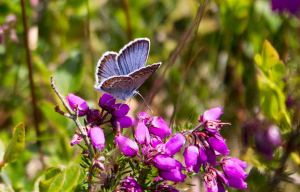Some of you may remember last year we reintroduced the Silver Studded Blue Butterfly onto Black Down. Since the start of the flight season for the butterfly a week or two ago we have been waiting with baited breath to see if the reintroduction worked. The butterfly has a short flight season, the species spends the rest of the year in other phases of its life cycle, as an egg, larva and pupa. Much of this time is spent with ants hidden away in the litter layer of the heath. Consequently the first chance to see whether the reintroduction had worked was this summer.
Yesterday whilst out checking the cattle on Black Down Jono, one of our Long Term Volunteers spotted something very exciting… A single Male Silver Studded Blue…
The species has made it through the winter and out the other side, it is such great news. Reintroducing species doesn’t happen very often, and it is a fantastic thing to be part of.
Obviously there is still a very long way to go, one swallow doesn’t make a summer as the saying goes, and one male certainly doesn’t make a viable population! But hopefully over the next week or two more butterflies will start to emerge. In the meantime we will also be carrying out further releases of butterflies from donor sites to boost the population and hopefully get the new colony properly established.
So glad it looks like it is starting to work though, these are the moments that make all the hard word worthwhile.










